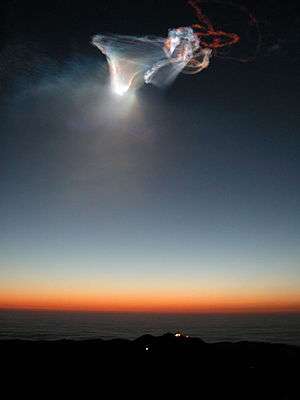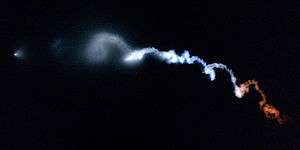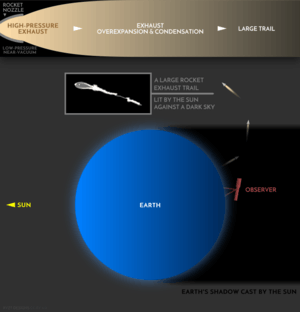Twilight phenomena
A twilight phenomenon is produced when exhaust particles from missile or rocket propellant left in the vapor trail of a launch vehicle condense, freeze and then expand in the less dense upper atmosphere. The exhaust plume, which is suspended against a dark sky, is then illuminated by reflective high-altitude sunlight through dispersion, which produces a spectacular, colorful effect when seen at ground level.


The phenomenon typically occurs with launches that take place either 30 to 60 minutes before sunrise or after sunset when a booster rocket or missile rises out of the darkness and into a sunlit area, relative to an observer's perspective on the ground. Because rocket trails extend high into the stratosphere and mesosphere, they catch high-altitude sunlight long after the sun has set on the ground. The small particles in the expanding exhaust plume or "cloud" diffract sunlight and produce the rose, blue, green and orange colors—much like a dispersive prism can be used to break light up into its constituent spectral colors (the colors of the rainbow) – thereby making the twilight phenomenon all the more spectacular.[1]
The exhaust plume may also take on a corkscrew appearance as it is whipped around by upper-level wind currents. It is typically seen within two to three minutes after a launch has occurred. Depending on weather conditions, it could remain in the sky for up to half an hour before dispersing.
At Vandenberg AFB in California, more than 1,800 missiles and space boosters have been launched from the central California coastline in northern Santa Barbara County since December 1958. However, only a small percentage of these launches have created the twilight phenomenon. The same is true with the U.S. Navy's Strategic Systems Programs, which conducts Trident II (D5) missile test flights at sea from Ohio Class SSBN submarines in the Pacific Test Range off the coast of Southern California, or Kokola Point at Barking Sands on the Hawaiian island of Kauai.
Some observers have wrongly assumed the missile or rocket creating the aerial spectacle must have malfunctioned or been destroyed while in flight. That belief stems from the appearance of the launch vehicle's contrail as it becomes twisted into knots by upper altitude air currents or wind shear. To date, no malfunctioning missile or rocket has been known to create the phenomenon. On the rare occasions when a missile or rocket does malfunction, it is destroyed by a Range Safety Officer before reaching the altitudes where twilight phenomenon occur.
The phenomenon's appearance and intensity varies with viewer location and weather conditions—typically, clear skies with no moonlight, since cloud cover would block one's view. The phenomenon can usually be seen throughout the state of California, and as far away as Arizona, Nevada and Utah. On the East Coast, similar sightings have been observed and reported during twilight launches of the space shuttle from NASA's Kennedy Space Center and other expendable launch vehicles from the U.S. Air Force's launch complexes at Cape Canaveral Air Force Station in Florida.
Numerous nations with a space program — such as the European Space Agency, the Russian Space Agency, the China National Space Agency, Japan's JAXA, India's ISRO and other countries have experienced the same event.
Examples

- In 2010 a contrail from an airplane in California had people believing they saw a missile launch.[2]
- On July 7, 2010, reports of a "UFO" sighting forced Xiaoshan Airport in Hangzhou, China to temporarily cease operations.[3] The event appears to have been sparked by a flight crew preparing for descent and detected the object—suspected to be a Chinese rocket test—as a bright twinkling light ‘above’ the runway and notified the air traffic control department. ATC could not locate it on radar and prudently waved off landing flights. Eighteen flights were affected. Though normal operations resumed four hours later, the incident captured the attention of the Chinese media and sparked a firestorm of speculation on the UFO's identity.
- On Nov. 7, 2015 a bright plume of light was seen expanding then "exploding" over south California between 7-8pm. The Orange County Sheriff confirmed this was in fact a Trident II ballistic missile test firing from the USS Kentucky.[4]
- On Sept. 2, 2015 a bright plume from an Atlas V rocket launching the MUOS satellite from Cape Canaveral Air Force Station was seen by observers in Florida
- On Dec. 22, 2017 a bright plume from a Falcon 9 rocket launching the Iridium NEXT 31-40 satellites from Vandenberg Air Force Base was observed. The launch occurred during sunset which caused "jaw-dropping views" of the ascent to space.
- On Oct. 10, 2018 this phenomenon was captured spectacularly over downtown Los Angeles in a timelapse[5] as the Falcon 9 rocket launched from nearby Vandenberg Air Force Base.
References
- https://www.afspc.af.mil/News/Article-Display/Article/251865/twilight-phenomenon-lights-up-sky/
- McKee, Maggie (2010-11-09). "Mystery 'missile' likely a jet contrail, says expert". New Scientist. Archived from the original on 2010-11-10. Retrieved 2010-11-10.
- "China Airport UFO - Mystery or Military?". National Ledger. July 10, 2010. Archived from the original on July 13, 2010. Retrieved July 11, 2010.
- "Mystery Light in Southern California Sky Sparks Anxiety - CNN.com". CNN. Retrieved 2015-11-08.
- "SpaceX Falcon 9 launch timelapse over downtown Los Angeles". Twitter. Retrieved 2020-08-15.
Video
- SpaceX Iridium 4 launch, as seen from Alhambra, Calif. Misrraim Sanchez YouTube video, Dec. 22, 2017
- Iridium NEXT IV launch, as seen from Manhattan Beach, Calif. Scott Gauer YouTube video, Dec. 22, 2017
- SpaceX Falcon 9 Launch, Boostback, Entry Burn Justin Foley's YouTube video, Dec. 22, 2017
- SpaceX launch video from Phoenix news helicopter Entire raw video as seen from PenguinAir Newschopper flying above Phoenix, Arizona Dec. 22, 2017
- Explaining The Amazing Rocket Trail Over LA Scott Manley's YouTube video, Dec. 24, 2017
- Falcon 9 rocket launch provides spectacular view in Bakersfield KBAK-29 Eyewitness News / KBFX-58 Fox News / BakersfieldNow.com (via YouTube), Dec. 22, 2017
- Justin Majeczky's 40-second time lapse of U.S. Navy Trident II (D5) missile test, as seen from San Francisco Vimeo, Nov. 8, 2015
- Missile launch over San Francisco YouTube video, Nov. 8, 2015
- Atlas V Rocket Launch view from East Orlando, Florida YouTube video Sept 2, 2015
- Night Time Launch Of Russian Space Rocket Heading To ISS YouTube video Feb. 15, 2014
- Video of "UFO" over Xiaoshan Airport in Hangzhou, China YouTube video July 7, 2010
External links
- A photographer shot an awesome time-lapse of SpaceX’s recent rocket launch from Yuma, Arizona The Verge, Dec. 26, 2017
- Dashcam video shows three-car crash as freeway drivers brake for SpaceX rocket launch Los Angeles Times, Dec. 26, 2017
- What was that light in the sky? SpaceX Falcon 9 launch offers dramatic show over L.A. Los Angeles Times, Dec. 22, 2017
- Light from Navy test fire courses across the Southern California and Arizona sky Los Angeles Times, Nov. 8, 2015 (The same missile launch as seen over San Francisco)
- Mystery light above L.A. brings fear, anger and questions Los Angeles Times, Nov. 8, 2015
- UFO scares are the price we pay for secret missile tests, expert says Los Angeles Times, Nov. 8, 2015
- Mystery light streaking across Bay Area skies was a test missile SF Gate, Nov. 8, 2015
- No UFO Here! Mysterious Flying Object Seen in Southern California Was Just a Missile Test People Magazine Online, Nov. 8, 2015
- Everybody lost it when a Navy missile lit up the night sky over the West Coast Business Insider, Nov. 7, 2015
- Rocket Trails at Twilight Illuminate the Sky
- Rocket Twilight Phenomenon
- 2020 Hindsight: Whee! Ooh! Aah! Pretty!
- Rocket puts on "Streak" show Santa Maria Times, Sept. 23, 2005
- National Defense Light Show Treebeard's Stumper Answer, Sept. 27, 2002
- Minuteman-II launch from Vandenberg AFB Goleta Air & Space Museum, July 14, 2001
- Rocket Launches Fred Bruenjes' Astronomy Stuff, June 7, 2007
- Space Archive
- SoCal SkyLights